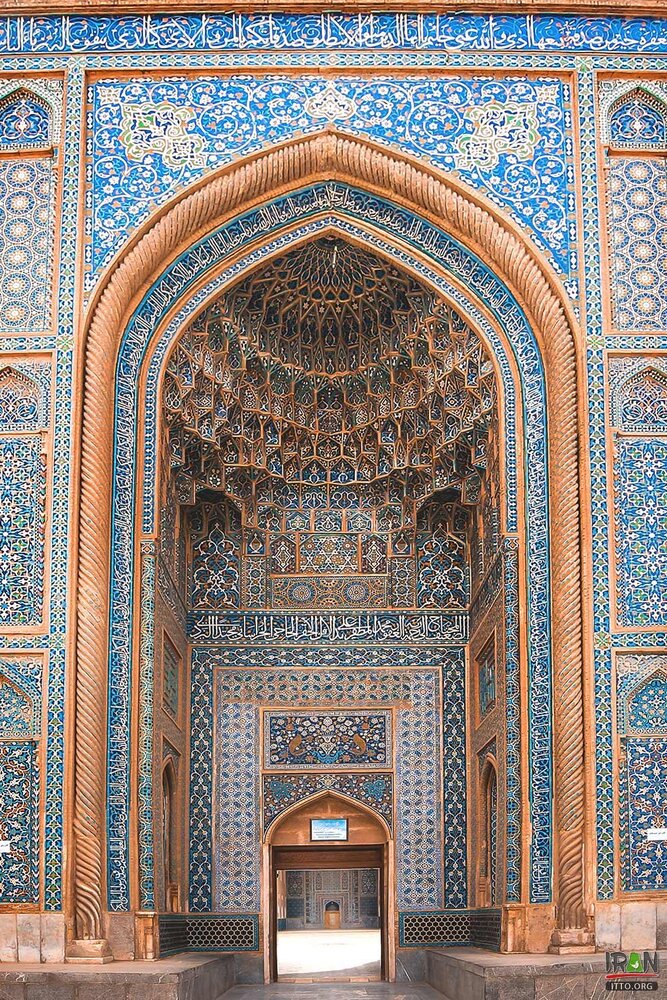Jameh Mosque of Kerman lures sightseers, historians for its location, design, and ornamentation

TEHRAN - Jameh Mosque of Kerman has long been a source of charm for history buffs, architects, and travelers to the ancient Iranian city.
Originally constructed in the 14th century, the congregational mosque boasts four lofty iwans (porticos), and loads of exemplar tilework, stuccowork, and masonry.
The monument has undergone extensive restorations during the Safavid era (1501 to 1736) and later periods. Furthermore, it is the earliest surviving example of Muzaffarid architecture, according to Archnet.
It was built in 1350 by Amir Mobarezeddin Mohammad-e-Mozaffari-e-Meybodi- Yazdi under the Muzaffarids, who pushed away from the Il Khanids after Abu Sa’id’s death in 1335 and established their own dynasty, ruling central Iran from 1314 to 1393.
The location of the mosque is of great significance as Kerman has been a cultural melting pot since antiquity, blending Persians with subcontinental tribes dwellers.
Such a position has led to the emergence of its famous, vibrant bazaar that begins at the Friday mosque’s rear portal and extends along the east-west axis, ending at the Arg Square.
The mosque is a feat of Islamic architecture for many reasons. Its continuous tile mosaic is, however, limited to certain areas-- the main portal and the facing of the arcade-- and is restricted to a four-color palette (white, yellow, and dark and light blue). In the court, tile mosaic in geometric patterns cover the arcade’s piers and the upper edge of the arcade’s frieze; the arcade’s spandrels are decorated with arabesque vegetal decoration of tile mosaic.
The iwan facing the court on the north is framed by a geometric arabesque pattern of tile mosaic inscribed into a geometric inscription band composed of rectangular tile mosaic pieces.
It is surmounted by a semi-dome ornamented with a geometric arabesque pattern in white and dark blue inscribing floral patterns and descending from a medallion at the top of the semi-dome.
The main entrance to the mosque is located to the north and is emphasized by its soaring portal iwan opposite a city square with a central pool. Two succeeding spaces lead through this portal iwan to the mosque’s court: an intermediary room, four meters square and surmounted by a dome, and an iwan facing the court. Two additional entrances are found on the south and west, extending beyond the rectangular perimeter of the mosque.
The mihrab -- a semicircular niche in the wall of a mosque that points out the qibla, the direction of the Kaaba in Mecca -- was installed in the sixteenth century, whereas the qibla wall and the two side walls date from the original construction. The mihrab is a half-octagonal niche in the qibla wall and is surmounted by a semi-dome comprising two muqarnas tiers of tile mosaics of arabesque motifs placed on top of a marble dado.
The arch of the mihrab is framed by a rectangular frame with an inscription band flanked by two rectangular panels of glazed tile mosaics of geometric arabesque motifs. Another inscription band marks the joint between the prayer hall’s walls and the room’s pointed barrel vault, which is decorated with glazed terracotta in yellow and blue.
The two walls adjacent to the qibla wall have only a marble dado on their base without any further ornamentation. Column-bounded prayer halls are integrated into the design and extend behind the arcade, aligning with the exterior walls of each of the four iwans (except part of the northern wall) and forming a rectangular outer perimeter of the mosque.
Moreover, the main portal iwan is decorated with an extraordinary variety of rectangular panels of geometric, floral, and vegetal motifs. An inscription band in white script on a dark blue background frames the external perimeter of the iwan.
The terms “Jameh Mosque” or “Masjed-e Jameh” or “Friday Mosque” are used in Iran for a grand communal mosque where mandatory Friday prayers are performed: the phrase is used in other Muslim countries but only in Iran does it designate this purpose.
AFM
Leave a Comment